

Living Large in a 130-Square-Foot Apartment. With dense urban centers and housing that was built hundreds of years ago, Europeans have long known how to make their tiny spaces feel triumphant.

But this apartment in the Montparnasse neighborhood of Paris is an above-and-beyond exemplar of hyper-efficient, micro-urban living. Architects Marc Baillargeon and Julie Nabucet carved a 130-square-foot space out of a Hausmann-style building to create a flexible yet utterly comfortable pied-à-terre. “Our approach to architecture is that the house is not so much a machine for living, but a tool for living well,” says Baillargeon. The apartment was once the master bedroom of a larger apartment, which should give you a pretty good idea of its postage-stamp size.
The idea was to separate the room to create a small studio that could create rental income. Chinese Graphic Design from the 1920's and 1930's. Nowadays it’s hard to imagine a time when graphic design didn’t involve sitting in front of a computer screen.

Perhaps that’s why it is so intriguing to look through this collection of vintage Chinese graphic designs from the 1920′s and 1930′s. The illustrations come from the book Chinese Graphic Design in the Twentieth Century by Scott Minick and Jiao Ping. Lu Xun, who introduced modern woodblock techniques to China, influenced many of the design artists at the time. See Also IN THE HEIGHT OF THE DEPRESSION: VANITY FAIR MAGAZINE According to 50 Watts, “Lu Xun taught many Western techniques [and] he always encouraged designers to seek inspiration in Chinese design history.”
Via: 50Watts. 100 Ideas That Changed Graphic Design. By Maria Popova.
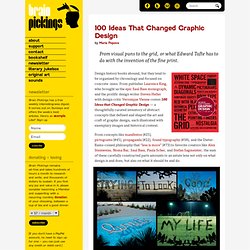
The Graff Ametis rain shower system is sleek, filled with LED lights, and sure to impress. Flash Dock — helpful photographic accessory or not-so-useful smartphone holder? IKEA introduces a clutter-free entertainment system: HDTV, media player included. You’d think that in the second decade of the 21st century, cords, wires, and antennas would be rendered obsolete.
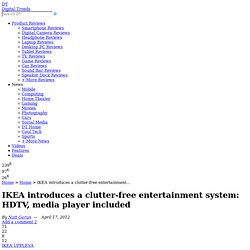
While we’re still on our way to a completely wireless lifestyle, IKEA has come up with an immediate solution to our hatred for cables with the UPPLEVA entertainment system that can discreetly hide your wires so you can enjoy a sleek and clutter-free room. The UPPLEVA system contains a smart TV that has all the outlets, USB, and HDMI slots along the sides, so it maintains a thin exterior. All the cable wires can be stored in the back of the television stand to keep them out of sight. And a universal remote control will be able to access all of these devices, sending sensor through the doors so you can keep everything looking minimal. The smart TV that comes with the set boasts full high definition display, LED technology, Wi-Fi integration, and 2.1 surround sound system.
Watch the promotional video for the UPPLEVA below. Here’s how one designer reimagined the Pringles chips packaging. Pringles are pretty delicious.

Where I used to work, the HR person will often restock the kitchen’s snack table with various goodies and Pringles were always the first to run out. But the tall, narrow tube design is difficult for sharing, and the more you munch into the chips, the deeper you have to reach into the tube. That’s awkward design. Dyson DC39 is a Topple-Free Vacuum From the Future. Charles Eames on Design: Rare Q&A from 1972. By Maria Popova A lucid reflection on the role and culture of design by one of the most iconic and influential designers of all time.

Legendary design duo Charles and Ray Eames shaped the mid-century modern aesthetic and influenced the voice of design for decades to come. They were also prolific filmmakers, perhaps best known for the iconic Powers of Ten film. Paul Rand on The Role of the Imagination. Dyson DC39 is a Topple-Free Vacuum From the Future. If contemporary standards of beauty and the beauty. Song Map Signed Limited Edition. Every Designer Should Start With Paper, Not Photoshop. Designers come from every background imaginable.
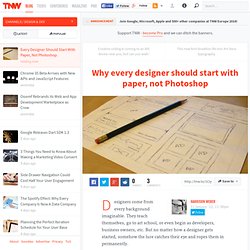
They teach themselves, go to art school, or even begin as developers, business owners, etc. But no matter how a designer gets started, somehow the lure catches their eye and ropes them in permanently. If you’re hooked, there’s typically no going back. You’ll begin absorbing everything you possibly can, reading books, watching tutorials, attending classes or browsing inspiration online. Advice to Sink in Slowly: Designers Share Wisdom with First-Year Students in Poster Series.
By Maria Popova Unpacking the secrets of happiness and creativity one poster at a time.
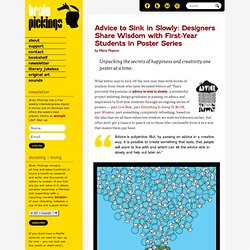
What better way to kick off the new year than with words of wisdom from those who have threaded before us? That’s precisely the premise of advice to sink in slowly, a wonderful project enlisting design graduates in passing on advice and inspiration to first-year students through an ongoing series of posters — part Live Now, part Everything Is Going To Be OK, part Wisdom, part something completely refreshing, based on the idea that we all have subjective wisdom we wish we’d known earlier, but often don’t get a chance to pass it on to those who can benefit from it in a way that makes them pay heed. Advice is subjective. A Giant Statue of Confucius by Zhang Huan. Arab Art in the Age of Revolution. For many Arabs, 2011 has been spent peacefully resisting police brutality, or watching events unfold through Twitter streams and grainy YouTube footage.
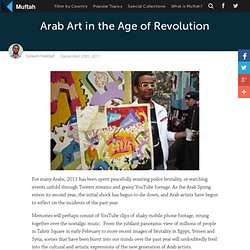
As the Arab Spring enters its second year, the initial shock has begun to die down, and Arab artists have begun to reflect on the incidents of the past year. Memories will perhaps consist of YouTube clips of shaky mobile phone footage, strung together over the nostalgic music. From the jubilant panoramic view of millions of people in Tahrir Square in early February to more recent images of brutality in Egypt, Yemen and Syria, scenes that have been burnt into our minds over the past year will undoubtedly feed into the cultural and artistic expressions of the new generation of Arab artists. In a photo-essay for the National Portrait Gallery, Malu Halasa reflects on the 2011 Arab revolutions and what it means for contemporary Arab photography, documentary and art. Making of Streamschool. From Frida Kahlo to Freud, Finger Puppets of Cultural Icons.
By Maria Popova Unibrows for fingers, or what Einstein’s ‘do has to do with silent film and the Cuban Revolution.
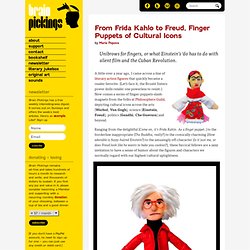
A little over a year ago, I came across a line of literary action figures that quickly became a reader favorite. (Let’s face it, the Brontë Sisters power dolls render one powerless to resist.) Now comes a series of finger-puppets-slash-magnets from the folks at Philosophers Guild, depicting cultural icons across the arts (Warhol, Van Gogh), science (Einstein, Freud), politics (Gandhi, Che Guevara) and beyond.
Ranging from the delightful (Come on, it’s Frida Kahlo. Andy Warhol Vincent Van Gogh Sigmund Freud. Asia Today: Chinese Fashion Designers Enter Online Luxury Market; Take Prada and Gucci to Task. This transcript has been automatically generated and may not be 100% accurate. ... the ... Chinese designers are coming into the spotlight in China's fast growing fashion world and every time you watching Asia today ... I'm joined by a light and style editor here in Asia and to buy ... Andrea so what's the golden opportunity here so ... as we've known for Wilder's huge appetite in China for one tree products ... the conventional thinking and so pretty recently is that that was can be limits to Western brands Gucci Burberry ...
Design Lessons From India's Poorest Neighborhoods. "Jugaad" is a Hindi term referring to the ingenuity of citizens living in resource-constrained environments, a concept from which New Yorkers might derive some enlightenment. Enter Jugaad Urbanism: Resourceful Strategies for Indian Cities, an exhibition created with the help of curator Kanu Agrawal that opens at New York's Center for Architecture next week. The exhibition is "design by the people, for the people, of Delhi, Mumbai, Ahmedabad, and Pune," says Agrawal, and showcases everyday innovations of slum-dwelling residents and the designers and architects who work around them. Agrawal, a Delhi native, studied at New Delhi's School of Planning and Architecture and worked with the acclaimed Achyut P. Kanvinde, and later completed his Master's in Environmental Design from the Yale School of Architecture. Kanvinde was one of the first to bring modern design to India.
Since New York shows draw a global audience, Agrawal expects the exhibition to resonate with diverse groups. 3.5 Inches - Dustin Curtis. I’ve been wondering why Apple chose to make the iPhone 4’s screen 3.5-inches when other comparable phones with Android and Windows Phone 7 have larger, more inviting screens. When you first see a phone with a 4-inch or larger screen, it seems like a much better experience. I thought it was a technical decision, and it could be, but since switching to an Android phone – a Samsung Galaxy S II, the “best Android phone you can buy, anywhere” – 15 days ago, I have realized another huge downside of larger screens: when holding the phone with one hand, I can’t reach the other side of the screen with my thumb.
Touching the upper right corner of the screen on the Galaxy S II using one hand, with its 4.27-inch screen, while you’re walking down the street looking at Google Maps, is extremely difficult and frustrating. This is an example of one of those design decisions that you don’t usually notice until you see someone doing it wrong.